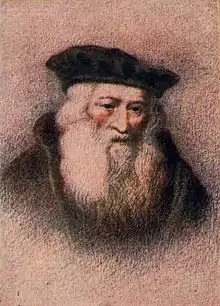Jacob ben Asher
Jacob ben Asher, also known as Ba'al ha-Turim as well as Rabbi Yaakov ben Raash (Rabbeinu Asher), was an influential Medieval rabbinic authority. He is often referred to as the Ba'al ha-Turim ("Master of the Columns"), after his main work in halakha (Jewish law), the Arba'ah Turim ("Four Columns").
Jacob ben Asher | |
|---|---|
 Jacob ben Asher | |
| Personal | |
| Born | c. 1269 |
| Died | c. 1343 |
| Religion | Judaism |
| Parents |
|
Biography
He was probably born in the Holy Roman Empire at Cologne about 1269 and probably died at Toledo, then in the Kingdom of Castile, about 1343.[1][2]
He was the third son of the Rabbi Asher ben Jehiel (known as the "Rosh"), a Rabbi of the Holy Roman Empire who moved to Castile, due to increasing persecution of Jews in his native Germany. Besides his father, who was his principal teacher, Jacob quotes very often in the Turim his elder brother Jehiel; once his brother Judah[3] and once his uncle Rabbi Chaim.[4] According to many, Jacob moved to Castile with his father and was not born there.
Some say Jacob succeeded his father as the rabbi of the Jewish community of Toledo (Zacuto), while others say his brother Judah ben Asher did. His brothers were also rabbis of different communities in Iberia. He lived in abject poverty most of his life, and according to the Sephardic Community of Chios, is said to have fallen ill and died with his ten companions on the island of Chios, in Greece, whilst travelling.[5]
Works
- Arba'ah Turim, one of the most important halachic books of all time. The work was divided into four sections, each called a "tur," alluding to the columns of jewels on the High Priest's breastplate.
- Sefer ha-Remazim, or "Kitzur Piske ha-Rosh" (Constantinople, 1575), an abridgment of his father's compendium of the Talmud, in which he condensed his father's decisions, omitting the casuistry.
- Rimzei Ba'al ha-Turim (Constantinople, 1500), a commentary on the Pentateuch, which is printed in virtually all Jewish editions of the Pentateuch. This concise commentary consists of mystical and symbolical references in the Torah text (see Masoretic text), often using gematria and acronyms as well as other occurrences of particular words elsewhere in the Torah.
- Perush Al ha-Torah, a less known commentary on the Pentateuch (Zolkiev, 1806). Its content is taken mainly from Nachmanides (often copied word-for-word), but without his cabalistic and philosophical interpretations. Jacob quotes many other commentators, among them Saadia Gaon, Rashi, Joseph Dara and Abraham ibn Ezra.
- Works of Jacob ben Ascher in the Gesamtkatalog der Wiegendrucke. Retrieved 2010-04-20
References
- Translated from Hebrew biography in Bar Ilan CD-ROM
- Goldin, Hyman E. (1961). Kitzur Shulchan Aruch - Code of Jewish Law, Forward to the New Edition. New York: Hebrew Publishing Company.
- See Tur Orach Chaim, § 417
- ib. § 49
- "The Sephardic Community of Chios". www.sephardicstudies.org. Retrieved 2017-08-20.
External links
 Works written by or about Jacob ben Asher at Wikisource
Works written by or about Jacob ben Asher at Wikisource